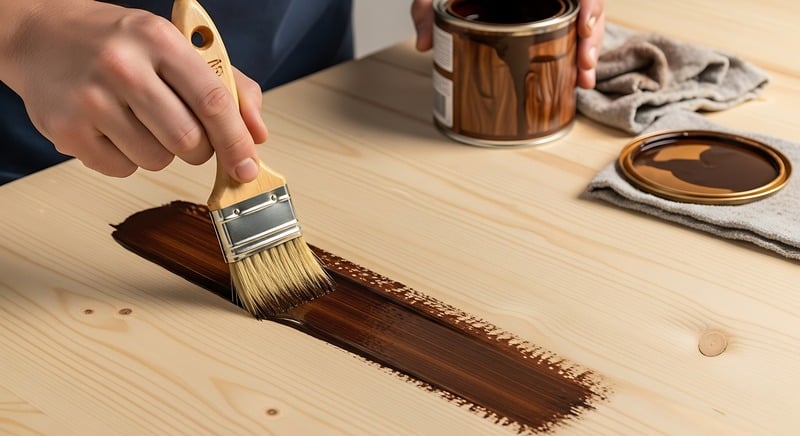Staining your home’s surfaces is an exciting and creative way to enhance the beauty of your living spaces. However, it’s also a project that requires a considerable amount of time, effort, and money. To ensure beautiful and appealing surfaces, it’s critical that you choose the right stain for your home. In this blog, we will explore different types of stains, discuss the factors that influence your choice of stain, and outline some common mistakes that you should avoid while staining your home.
What Is Stain?
A stain is a colored liquid or gel that is used to finish a wooden surface. A stain contains pigments or dyes dissolved in a solvent, like water, oil, or alcohol. This solvent is absorbed into the wood, altering its color and enhancing its grain, a process known as staining. Unlike paint or varnish, a stain is applied to bare, sanded wood and does not form a protective coating. There are different types of stains that vary in terms of opacity, the type of solvent, and their ability to penetrate wood.
Types Of Stain
There are various types of stains available in the market. The type of stain you should choose depends on the type of wood you have, the area in your home where the wooden surface is located, and, ultimately, your personal preferences. Here are a few options:
Oil-Based
Oil-based stain is one of the most well-known and widely used types of stain. Oil-based stains are made from linseed oil, which allows them to dry slowly, giving you ample time to make corrections to the surface. An oil-based stain requires thinning and cleaning, which is why it is used with a paint thinner. Paint thinner emits strong, flammable fumes and is not easily disposed of. Therefore, we recommend working with a professional painter if you want to stain your wood using an oil-based stain.
Water-Based
Water-based stains are easier to use than oil-based stains, which typically require the use of a paint thinner. Water-based stains are also easier to clean and contribute less to pollution. However, there is one difficulty when applying a water-based stain: it raises the grain in the wood and dries quickly. Therefore, if you are new to staining, professional help is essential. Water-based stains are best suited for use with water-based finishes, resulting in a smooth finish.
Gel
When staining pine wood, it is recommended to use a washcoat or wood conditioner before applying the stain. That is because pine does not work very well with most stains. However, gel stains are best suited for pine. They allow you to skip the washcoating and conditioning steps and apply the stain directly. A gel-based stain can work with all types of wood that are prone to blotching, similar to pine. However, the gel is rather thick and can be messier to work with, requiring more cleanup.
Acrylic
Acrylic is a less popular type of stain, but it has its fair share of advantages. Unlike oil-based stains, acrylic stains can dry very quickly, making them ideal for time-sensitive projects. Acrylic stains are also very easy to use and apply (they do not require paint thinners) and do not create as much of a mess as oil-based or gel stains. Acrylic stains are also easier on the senses and are a more eco-friendly option. The only drawback is that they do not penetrate the wood as deeply, so you may need to apply multiple coats to achieve rich results.
Choosing The Right Stain For Your Home
Several factors come into play when choosing the right stain for your home. Here are a few considerations you should make:
Match the Wood or Surface Type
The type of wood you have in your home directly influences the type of stain you should choose. Different woods have varying porosity and grain, which affects how the stain penetrates the wood. Soft woods like pine require gel-based stains, while harder woods like oak absorb stain more evenly, allowing you to apply oil- or water-based stains to them.
Choose a Stain Based On the Application Area
There are many wooden surfaces around a home, such as fences, decks, and floors. Which area are you planning to stain? This matters because different stains have varying durability, and you do not want to use a less durable stain, such as acrylic, on high-traffic areas like a staircase railing or an outdoor deck.
Consider Your Home’s Design
Your overall interior design is also a significant factor when it comes to staining. The transparency of the grain, the color, and the undertones are a few considerations that, if taken into account, can help you enhance the overall appearance and character of your home. Select a color and grain transparency that complements the existing colors in and around your home.
Environmental Factors
Considering environmental factors, such as your local climate, sun exposure, and moisture issues, will help you choose the right stain. You should also consider the health impact of the stain itself. Choose low-VOC stains, such as water-based and acrylic stains, to minimize air pollution and prevent exposure to harmful chemicals.
Choose Proper Opacity
If you have a desired appearance in mind, it’s crucial that you consider the opacity of the stain you are working with. Not all stains have the same opacity. Some stains, such as acrylic and water-based stains, are translucent and show grain, while others, such as gel and oil-based stains, are semi-transparent. You can also apply multiple coatings to control the opacity.
Maintenance & Durability
When choosing a wood stain, consider the climate to select stains with UV and mildew resistance, allowing you to extend their durability. Prioritize penetrating stains, such as oil-based stains, if durability is what you are most concerned about. Homeowners often choose dark colors because they hide dirt and appear cleaner, but it’s essential to consider that dark colors require more maintenance and cleaning than light colors, even though light colors tend to fade faster.
Test the Stain Before Applying
It’s good practice to test the stain before applying it. You can either test it on a piece of scrap wood or on a hidden area of the floor or deck. This test will tell you how the wood will absorb the stain, how the end result will look, and what kind of final color, appearance, and feel you can expect. Ensure the stain is completely dry before confirming the results.
Mistakes To Avoid
If you are DIY-ing your wood staining project, it’s easier to make a mistake, especially if you are new to DIY painting projects. Here are a few common mistakes you need to avoid.
- Improper preparation of surfaces before applying stains: Before you begin staining, ensure that you prepare the surfaces by cleaning and thoroughly sanding the wood. If you sand the wood after staining, there is a risk that you may sand through the stain and create a mess.
- Not considering maintenance/durability issues: Stains are not only about color, opacity, and penetration. Different stains have varying durability and maintenance requirements, so it’s essential to consider their durability before applying them.
- Not testing the stain: Testing the stain is highly important because you may not achieve the “desired” results with the stain if you do not apply it properly. Testing allows you to ensure the accuracy of your process before implementing it on a large scale.
- Not considering the surroundings: The surroundings include the climate, the location (outdoor/indoor) of the wood, and the design elements in your home, such as color and ambiance. If you don’t consider all of these factors, you will probably not achieve the desired results.
Summary
Staining wood can definitely amplify its beauty, appeal, and durability. However, the staining process is not simple. You must select the appropriate stain based on the type of wood you have, and then consider a few additional factors, such as your home’s design, the application area, maintenance requirements, and the surrounding environment, to ensure optimal results.
All of this can seem like a daunting and expensive task. That is why Boise Painting offers reliable, durable, and cost-effective staining services. We can transform the look and feel of wooden surfaces in your home without any mess, ensuring every corner, both inside and outside, is beautiful and appealing. Schedule a consultation today.











